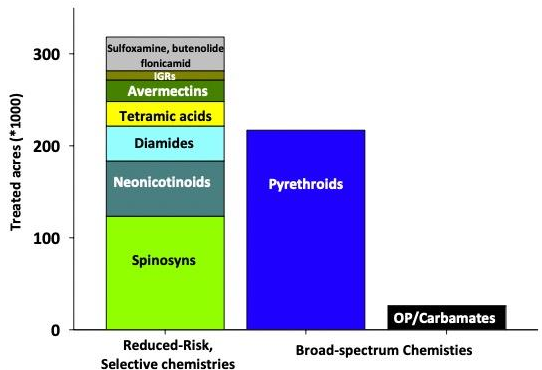
|
|
|
|

|
|||
|
|
|||
The results of our annual Lettuce Insect Losses surveys continue to show interesting trends in insecticide usage on desert lettuce. In general, the most commonly used insecticides in fall and spring lettuce correspond directly to the key pests that typically occur during these growing periods. Overall, insecticide use on lettuce was down in 2018-19 compared with previous years. By far, the pyrethroids applied both as foliar sprays and through chemigation at stand establishment were the most commonly used insecticide class. Not surprising. Over the past 15 years, pyrethroid usage has remained steady and the reason for this is quite clear. Pyrethroids are the most inexpensive and safe broad-spectrum insecticides still available for use in tank-mixtures for effective control of beetles, crickets, plant bugs and some Lepidopterous larvae and adults (looper and corn earworm). The overall use of OPs and carbamates continues to decline, but usage increased slightly compared the 2017-2018 season. Lannate (methomyl) usage was comparable to last year and acephate usage was up slightly on spring lettuce this season due to heavier aphid and late-season thrips pressure. In the past few years, OPs/carbamates have been increasingly replaced by several reduced-risk chemistries, of which the spinosyns are the most commonly used class of selective insecticides. Radiant usage against both lepidopterous larvae and thrips has remained steady over the past 15 years, averaging over 2 sprays per treated acre, but was down in 2018-19. Their use against both lepidopterous larvae and thrips has remained steady since they were first registered. The Diamides (Coragen, Voliam Xpress, Vetica, Belt) were another commonly used selective chemistry in lettuce this season. Since they were first registered in 2008, PCAs have steadily incorporated this new chemical class into their management programs, but usage dropped by about 25% in fall lettuce in 2018. The use of soil diamides was down significantly in 2018-19. Another important class of chemistry used in fall and spring lettuce are the neonicotinoids (the 3rd most commonly used chemistry in lettuce in 2018-19) driven primarily by soil-applied imidacloprid for whiteflies and aphids. The usage of imidacloprid on both fall and spring lettuce has increased markedly since 2009, but usage last season decreased significantly where it was used on less than 80% of lettuce acres. Although Movento was used on fewer fall and spring lettuce acers in 2018-19, it remains the second most commonly used product for aphid and whitefly control. Finally, among all insecticide chemistries, the broad spectrum, consumer–friendly pyrethroids have been the predominant chemistry applied to lettuce. However, for the past eight seasons PCAs treated a greater percentage of their lettuce acreage with selective, reduced-risk products than with the broadly toxic, OP/ carbamate chemistries. To view a summary of the estimated insecticide usage by chemical class, as well as the most commonly used insecticides on fall and spring lettuce this past growing season, go to Insecticide Usage in Desert Lettuce, 2018-19 | |||
| Back | |||
|
For questions or comments on any of the topics please contact Marco Pena at the Yuma Agricultural Center.
|
|||
|
Home |
Cotton | Veggies |
Forages | Grains
| Citrus |
Crop x Crop Insects | Diseases| Weeds | Pesticides | Economics | News | Weather | Research | Photos | Contacts | General Info. Copyright © 2001 University of Arizona, College of Agriculture and Life Sciences Webmaster: Al Fournier (acis@ag.arizona.edu) |
|||


